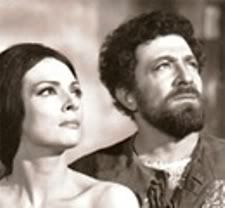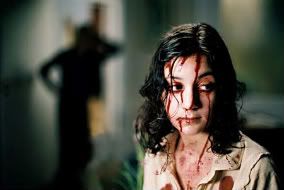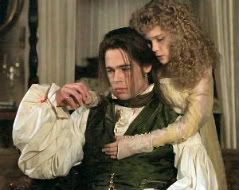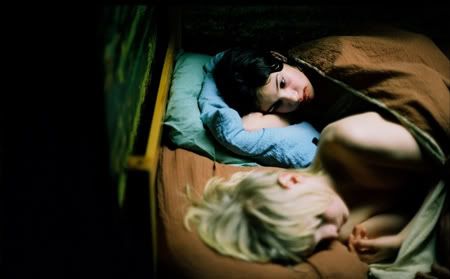This happens a few times until lucky number three, usually a sister of the other two, devises a clever plan to avoid dropping the key/egg or alert some sort of lover or brother of her predicament. This wife is rescued, and sometimes rescues the other wives, who can be sewed back together or pulled out of hell or otherwise recovered. The story is a flip-side of "Beauty and the Beast," where the vicious new husband really is a monster who cannot be redeemed, and where the woman's main attribute, curiosity, gets her into trouble. I suppose the lesson is that marriage is scary for a young girl, and sometimes the vicious beast turns out to be all right—and sometimes he doesn’t.
This basic storyline is more or less absent from Bartok’s opera Bluebeard’s Castle and Michael Powell’s 1963 film for German television. This film is very rare, and a few weeks ago I got the opportunity to see the one print that’s available. According to Powell’s wishes, the German opera is presented without translation, and only a few descriptive subtitles cue you in to certain emotions or events. (You can see the first 9 minutes here)

(click "Read More" for the rest, including slight spoilers for a film you probably won't see)
The experience is hard to describe. The film is an hour of visual interpretation of Bluebeard’s seven doors, the only action being that Bluebeard brings his new wife, Judith, home and informs her he has seven doors that she cannot look behind. The "public" part of his castle is filled with abstract sculptures of body parts; the first thing Judith says is that she’s going to bring happiness and light into it. She then proceeds to gain entry into each room, and the opera/movie follows a pattern in which Bluebeard denies her, then relents, she is fascinated by what she sees, and at length somewhat troubled. She keeps seeing blood. On the crown, on the clouds, marring the beauty of the things Bluebeard is showing her.
This, of course, is present in the opera itself, and what Powell’s film does is bring movie technique to a rather stagey production design. The film did not have a lot of money to work with, but what was achieved was a sort of synthesis of film and stage technique; everything we see could have been used on stage, but the camera allows Powell to play with time and point of view. The doors are sometimes represented by monoliths in a room, sometimes by transparent doors with little relation to any actual architecture. The flowers in the garden look to me like lighting gels. The basic unreality of the setting (and the lack of subtitles) allow for a multitude of interpretations; I don’t think anyone in the theater that night saw the same film. Why does Bluebeard show Judith the torture chamber and armory first, and with minimal reluctance, while the lake of tears takes significant prying? Are his wives, behind the last door, really dead? Or do they symbolize the memory of his past loves, as is suggested by his comparing them to dawn and midday? In the end, why can’t they be together? Was Judith too curious, or Bluebeard too reticent? Is any of this real, and if not, whose head are we in?
Unlike the original stories, Bluebeard does not leave his wife alone in the house as a sort of trick. He is present the entire time, and gives in to her demands to see each successive room. He is not a hideous monster—often interpreted in old illustrations as having "Eastern" features—but a strong-looking curly-haired man. It is not even clear whether there is any actual blood, or whether it is Judith’s imagination which coats Bluebeard’s inner life with it. But because the opera is called "Bluebeard’s Castle," anyone watching it with knowledge of the story is going to bring it to bear on what they’re seeing. This, for me, was one of the most interesting aspects of the thing. Because to me, most of it was happening not in real rooms but in the emotional lives of the protagonists. And to do Bluebeard without the dead wives, without the slaughterhouse, performed in large part on the marital bed, brings out so many new elements that I almost don’t know where to begin.
As we’ve seen in the trajectory of stories like Beauty and the Beast and Phantom, there is a movement from fear to sexualization of the Other. This is obviously far too simplistic a notion, but in general the Beast and the Phantom have become more acceptable partners, even in their inhumanity. Bartok/Powell’s Bluebeard does not seem like a monster at all, but a somewhat prickly man who presents a not inconsiderable sexual allure for his new wife. This interpretation seems to put the former bloodiness of the story down to anxiety over sexuality; without that anxiety, there is no need to warn the woman off the appetites of the husband. What was once threatening is now actually attractive. And the fact that Bluebeard can more easily show Judith his torture chamber and armory is in keeping with the abstract threat of the main chamber of his home. He is fine with this perception of him, and Judith is as well. These first rooms are his defenses as well as the basis of his masculine appeal, and it’s telling that he presents them before showing her the treasure and the gardens, and likewise telling that upon seeing the first rooms she only wants more. Of course in the end, she joins his other loves in the room of maybe-he-killed-them-and-maybe-he-didn’t, but the threat here seems more emotional than to life and limb.
And that may represent a very basic shift in society, in terms of what marriage means and what perils await most people in first world countries. It’s not that the original story assumed that many marriages ended in the husband hacking the wife up, but marriages were much more likely to be arranged without the consent of the girl, and life was a lot more difficult. In the early 20th century, when the opera was written, marriage was a choice, a little danger had become alluring, and the consequences were no longer the same.
Read more!
 In many ways, while less subtly stylish, George Romero's Martin (1977) is the male companion piece to Let the Right One In. They're both about adolescence--the boy version naturally featuring an older protagonist. Martin's sexual anxiety manifests in a different way than Eli's, and his condition is ambiguous in a different way, and in the end the films are saying quite different things. But they both focus on individual (arrested) development, with vampirism as the diegetic cause of the arrest. What's unique about Martin's situation is that while he may or may not be a vampire, his reasons for thinking/pretending he is seem to be equal parts sexual (assuming his blood drinking falls into the "fetish" category) and a cry for attention (as exemplified by his anonymous late-night radio talk show calls). Martin makes the rape-fantasy aspect of the vampire myth explicit, and also explores the psychological hold the myth has on us for the simple reason that Martin is under its spell as well--whether or not he's a "real" vampire. Whatever that means.
In many ways, while less subtly stylish, George Romero's Martin (1977) is the male companion piece to Let the Right One In. They're both about adolescence--the boy version naturally featuring an older protagonist. Martin's sexual anxiety manifests in a different way than Eli's, and his condition is ambiguous in a different way, and in the end the films are saying quite different things. But they both focus on individual (arrested) development, with vampirism as the diegetic cause of the arrest. What's unique about Martin's situation is that while he may or may not be a vampire, his reasons for thinking/pretending he is seem to be equal parts sexual (assuming his blood drinking falls into the "fetish" category) and a cry for attention (as exemplified by his anonymous late-night radio talk show calls). Martin makes the rape-fantasy aspect of the vampire myth explicit, and also explores the psychological hold the myth has on us for the simple reason that Martin is under its spell as well--whether or not he's a "real" vampire. Whatever that means.



